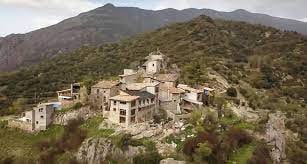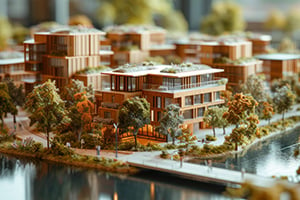By Chloe Kiernicki
Engineering Analyst
Sustainable Investment Group (SIG)
In February, GBES, SIG’s training partner, hosted Emmanuel Pauwels to discuss regenerative design at Cal Guerxo, a Living Building outside of Barcelona.

Emmanuel is the founder of Green Living Projects, a green building consulting firm and education company in Spain. He started primarily working with LEED certification and has since grown to include FITWEL, WELL, and more. When he entered the green building world, there were few others in this field, but Emmanuel has led the way in Spain and took the initiative to develop Green Rater training in Europe which led to the development of the Green Rater European Network.
 After Emmanuel attended a presentation on the Living Building Challenge, he was inspired by the mission but felt that the process and certification was too far out of reach. This sentiment is common given the level of intent, time, and up-front costs of the LBC, but Emmanuel was so struck by the impact of the concept that he pushed ahead. When he purchased an old residence in the Pyrenees Mountains of northern Spain he started planning for how the house could be renovated to achieve Living Building Certification.
After Emmanuel attended a presentation on the Living Building Challenge, he was inspired by the mission but felt that the process and certification was too far out of reach. This sentiment is common given the level of intent, time, and up-front costs of the LBC, but Emmanuel was so struck by the impact of the concept that he pushed ahead. When he purchased an old residence in the Pyrenees Mountains of northern Spain he started planning for how the house could be renovated to achieve Living Building Certification.
The Living Building Challenge is a regenerative design tool that centers on the idea that buildings can bring about a positive impact on the earth and environment. The initiative is intense and requires careful planning that must begin well before the site is constructed or renovated; while this is often true for certifications such as Energy Star and LEED, LBC includes seven petals that extend far beyond energy consumption and efficiency. Certification depends not only on plans and systems in place, but on performance metrics that are measured during one year of occupation. The seven petals of the Living Building Challenge are place, water, energy, materials, beauty, health and happiness, and equity. Cal Guerxo addresses each in the following ways:
- Place
The place petal asks that designers look where they build. When first starting his journey with Cal Guerxo, Emmanuel spoke directly with the other households in this mountain village to learn more about the community and get a sense of the place. By renovating an existing house, the environmental footprint of the project was minimalized from the start. Cal Guerxo reconnects the inhabitant with food production by including agriculture on the site as part of a larger energy management system. Emmanuel also took into account the public transport network and having a train station nearby connecting Cal Guerxo with Barcelona was an important criterion as part of the requirements of the petal regards transportation and access to public transportation to minimize automotive transport.
- Water
 The water petal requires that the building only utilize rainwater that falls on the site. To determine how the site could capture enough water for the home, Emmanuel created a rain budget. The budget calculates the amount of rainwater available and how much greywater can be recycled for use for human consumption and for agricultural irrigation. Through Emmanuel’s efforts in minimizing water consumption, capturing water from the street, and using multiple filters and tanks for purification, Cal Guerxo is able to consume and return 80,000 liters of rainwater to the garden every year.
The water petal requires that the building only utilize rainwater that falls on the site. To determine how the site could capture enough water for the home, Emmanuel created a rain budget. The budget calculates the amount of rainwater available and how much greywater can be recycled for use for human consumption and for agricultural irrigation. Through Emmanuel’s efforts in minimizing water consumption, capturing water from the street, and using multiple filters and tanks for purification, Cal Guerxo is able to consume and return 80,000 liters of rainwater to the garden every year.
- Energy
 The energy petal necessitates a net positive carbon footprint. To reach this goal, Emmanuel looked at how nature could help. He measured the wind on the site for a year to discern how to design the renovation of the house to best utilize the passive cooling of the breeze. He also looked at how the shade of the tree adjacent to the house could be beneficial. The house has radiant heating in the floors and the walls that provides delight through thermal variation. The site runs completely on electric power that is harnessed from solar panels. Due to these passive heating and cooling methods and other intentional consumption reductions, the house produces 7% more energy than is consumed annually and is prepared for a week of stored power in the event of a natural disaster.
The energy petal necessitates a net positive carbon footprint. To reach this goal, Emmanuel looked at how nature could help. He measured the wind on the site for a year to discern how to design the renovation of the house to best utilize the passive cooling of the breeze. He also looked at how the shade of the tree adjacent to the house could be beneficial. The house has radiant heating in the floors and the walls that provides delight through thermal variation. The site runs completely on electric power that is harnessed from solar panels. Due to these passive heating and cooling methods and other intentional consumption reductions, the house produces 7% more energy than is consumed annually and is prepared for a week of stored power in the event of a natural disaster.
- Materials
 The materials petal dictates a “red list” of material ingredients that cannot be used on the site because they are harmful for planet and people. There is an emphasis on reducing waste, reusing materials, and sourcing materials within three different rings of locality. Where it was possible, Cal Guerxo reused materials from the initial home that stood on the site, and elsewhere utilized natural materials such as lime, sand, clay, and straw that were finished by local artisans.
The materials petal dictates a “red list” of material ingredients that cannot be used on the site because they are harmful for planet and people. There is an emphasis on reducing waste, reusing materials, and sourcing materials within three different rings of locality. Where it was possible, Cal Guerxo reused materials from the initial home that stood on the site, and elsewhere utilized natural materials such as lime, sand, clay, and straw that were finished by local artisans.
- Beauty
The beauty petal is driven by the concept of biophilia, which explores the relationship beauty and nature. Cal Guerxo fosters this through creating an earthy feeling throughout the site by utilizing earthy colors, materials, and shapes. Most directly, to connect the site to the surroundings, the house frames views out into nature in windows and creates outdoor living spaces that use natural materials to blur the boundary between interior and exterior. The beauty petal helps transform the maintenance of the site into a committed caring.
- Health and Happiness
The health and happiness petal aims to improve physical and mental health through a healthy indoor environment and design features for human delight. The absence of toxic Volatile Organic Compounds in the materials and the ventilation strategies provide a high indoor air quality which is monitored continuously. The natural pond attracts native pollinators and brings a sense of happiness to human visitors alike.
- Equity
 The intent of the equity petal is to foster inclusive communities that provides everyone involved in the project opportunities to grow. Cal Guerxo allowed the team of Green Living Projects to get hands-on experience in regenerative design while some of the local craftsmen were trained to build an energy efficient building envelope. Advancing specialized skillsets among the local tradesmen. An important part of the construction was done with volunteers living and working at Cal Guerxo while learning new building skills as well as an in depth understanding of regenerative design.
The intent of the equity petal is to foster inclusive communities that provides everyone involved in the project opportunities to grow. Cal Guerxo allowed the team of Green Living Projects to get hands-on experience in regenerative design while some of the local craftsmen were trained to build an energy efficient building envelope. Advancing specialized skillsets among the local tradesmen. An important part of the construction was done with volunteers living and working at Cal Guerxo while learning new building skills as well as an in depth understanding of regenerative design.
While the Living Building Challenge provides the vision from which Emmanuel and his team at Green Living Projects begin, Cal Guerxo exemplifies the value of striving beyond. Emmanuel focused on moments of sharing within natural systems and the ability of human occupation to nestle into this existing ecosystem.
Energy Star and LEED once seemed out of reach and too challenging to achieve, yet the programs have advanced the built environment toward greater environmental efficiency and become more commonplace over the past three decades. That is the hope with the Living Building Challenge as well: over time, the necessary networks to facilitate the adoption of the seven petals will grow and foster greater intention in designing existing and new facilities.
 Emmanuel’s background in LEED, FITWEL, WELL, and more led him to the next logical advancement: the Living Building Challenge. Here at SIG, we are eager for our own progression along this trajectory of improving the impact of the built environment. If you are interested in learning more about the story of Cal Guerxo, be on the lookout for the next continuing education session with Emmanuel and GBES! Additionally, you can follow the growth of Cal Guerxo on their facebook page or their Instagram page @Calguerxo.
Emmanuel’s background in LEED, FITWEL, WELL, and more led him to the next logical advancement: the Living Building Challenge. Here at SIG, we are eager for our own progression along this trajectory of improving the impact of the built environment. If you are interested in learning more about the story of Cal Guerxo, be on the lookout for the next continuing education session with Emmanuel and GBES! Additionally, you can follow the growth of Cal Guerxo on their facebook page or their Instagram page @Calguerxo.
Watch the Cal Guerxo Webinar Replay here
Source: International Living Building Challenge Institute
Photo credits: Emmanuel Pauwels
© 2021 Sustainable Investment Group (SIG). All rights reserved.



